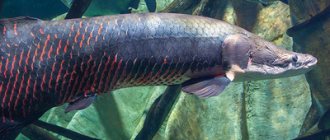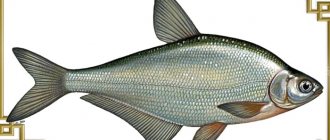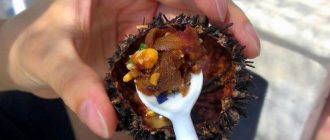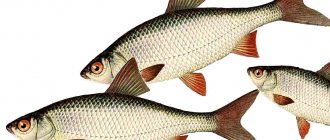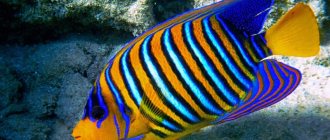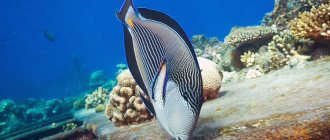Considered one of the largest freshwater fish today, the arapaima has many names. Pirarucu is one of them, as this fish is called by the natives of Peru. It translates as “red fish” and is due to the red hue of the meat and rich red spots on the scales. Arowanas are considered close relatives of this giant fish. All these freshwater animals belong to the Aravanidae group.
This fish has several names
General information
Unfortunately, the lifestyle of these ancient freshwater animals has been practically not studied. The main sources of information are various narratives of tourists, which are often unreliable. Local residents, who have been fishing arapai for many years, have not carried out any scientific research. The Indians saw the “red fish” only as a source of food.
The Latin name "Arapaima gigas" was formed by combining several words from different languages. The people of Peru called the fish arapaima or arapaima. "Gigas" means "giant" in Latin. Other names, pirarucu and paiche, may have come from one of the local dialects.
This fish lives in water bodies
Habitat
Arapaima gigas are found in Guyana, Peru and Brazil - in rivers that connect to the Amazon. In the Amazon itself, arapaima fish can be found quite rarely. It prefers the rugged coasts of reservoirs , which are overgrown with coastal algae, when large floating meadows are formed, in which the fish are almost invisible.
It can also be found in swamps and lakes, and during the monsoon season it can also be found in tropical forests that have been flooded. The water in its habitat is quite warm (26-30 degrees), the pH level is 5.2-5.7 (“slightly acidic” reservoirs), with a water hardness of 12. Most of the time the fish sticks to the bottom.
In this video you will learn more about this fish:
External description
Pirarucu fish has a rather exotic appearance. The body is compressed at the sides and has a long shape:
- The scales have a relief shape, are hard and quite large in size. The diameter of the scales of an average individual is more than five centimeters. The ends of all scales have a rich red border.
- The mouth is quite large and has an upper position.
- The head is significantly elongated and flattened closer to the top, so it looks small against the background of the gigantic body. On top there are keratinized plates.
The strength of the scales of this fish is unique. The elasticity coefficient (a physiological indicator of the ability of a body or substance to deform under the influence of mechanical force) is tens of times higher than that of the bone skeleton.
This fish has three fins
The scales have a multi-layered structure, due to this the arapaima can survive when it is in the vicinity of piranhas in small reservoirs that are separated from the river during drought.
An adult arapaima has different shades:
- the head at the front has a brown-olive color, tinged with a green-blue tint;
- near the pelvic fins, a transition to pink begins to occur and closer to the tail part the body acquires a dark red color.
The location of the fins is quite peculiar. The unpaired fins are located quite close to the caudal fin and are very large, while looking almost symmetrical. The paired ventral fins are also strongly displaced towards the caudal region.
The crowded location of the fins is quite conditioned. The wide tail blade and all three fins simultaneously create an “oar”, allowing the fish to attack its prey and giving acceleration.
Arapaima scales
The strength of arapaima scales is so phenomenal that it is difficult to imagine. The modulus of elasticity (a physical measure of the ability of a body or substance to undergo deformation under the influence of force) was 10 times higher than that of bone.
Note: The scales have a multi-layered structure, thanks to which the arapaima is able to survive safely in the company of piranhas.
Body size
It is believed that the largest individuals reached 4.6 meters. But there is no scientific evidence for this. The record length is a specimen measuring 2.49 meters, which was caught in 1979 in Brazilian waters.
In the work "Fishes of Guiana", which was written by Shom Burkum after traveling to this country in 1837, it is written that the greatest length of the pirarucu is 15 feet (437 cm). However, this size is taken from Aboriginal stories. Therefore, there are certain doubts about the reliability of this information.
On average, the length of this fish is 2.5 m.
Natural enemies of arapaima
Photo: River arapaima
It is no wonder that such a colossus as the arapaima has practically no enemies in natural conditions. The size of the fish is truly colossal, and its armor is simply impenetrable; even piranhas avoid this giant, because they are not able to cope with its thick scales. Eyewitnesses claim that sometimes alligators hunt arapaima, but they do this infrequently, although data regarding this information has not been confirmed.
The most insidious enemy of the arapaima can be considered a person who has been hunting the giant fish for many centuries. The Indians living in the Amazon considered and still consider this fish to be their main food product. They long ago developed tactics for catching it: people discovered the arapaima by its noisy breath, after which they caught it using a net or harpooned it.
Fish meat is very tasty and nutritious; in South America it is very expensive. Even the ban on catching arapaima does not stop many local fishermen. Indians use fish bones for medicinal purposes and also make dishes from them. Fish scales make excellent nail files, which are incredibly popular among tourists. Nowadays, too large specimens of arapaima are considered very rare, all due to the fact that for many centuries the Indians uncontrollably caught the largest and heaviest specimens.
Respiratory system
Pirarucu is not the only fish that can breathe atmospheric oxygen. Its close relatives, the arowanas, have the same ability, for example, the platinum arowana.
Living in bodies of water with a small amount of oxygen occurs due to the special structure of the swim bladder, which plays the role of a lung:
- The swim bladder is quite large.
- The tissues of the bladder have cellular walls, where there is a huge network of blood capillaries.
The gill respiration of the pirarucu can provide only 25% of the fish's oxygen needs; the remaining 75% of the arapaima's oxygen is obtained from atmospheric air. To do this, an adult floats up to the surface of the reservoir every 20 minutes. Young animals need to surface for oxygen more often.
Sticking its mouth out of the water and opening it wide, the arapaima makes a clicking sound, thereby releasing air from the bubble, drawing in a new portion of oxygen.
Piraruku vulnerability
The “pulmonary” respiratory system of this fish is so specific that it made it quite vulnerable. The sound that is made when the mouth opens is a signal to fishermen.
If arapaima swims to the surface, then the water surface begins to resemble a whirlpool. The fishermen immediately notice him and throw a sharp harpoon into the center of the whirlpool. It's not always possible to hit the fish.
Having emerged from the center of the whirlpool with its mouth wide open, the piraruku releases “recycled” oxygen with a sharp sound, immediately inhales and immediately closes its mouth, sinking to the bottom. This lasts no more than 2-3 seconds.
This fish has a vulnerability
Anglers prefer to catch arapaima in small (no more than 120 meters in size) lakes, where it is quite easy to notice whirlpools. And at a certain moment, fishermen may be lucky - they will fall into the body of a fish that has risen to breathe air.
Security measures
For a long time, the meat of this fish has been the basis of the diet of the inhabitants of the Amazon, just like arowana - of the population of Asia. But as soon as nets began to be used, the piraruku simply disappeared in most rivers. If only an adult individual could be caught with a harpoon, then fry were also caught with a net, so the population began to decline significantly. Fish larger than two meters have become caught quite rarely.
Deforestation affects these fish
The situation has become an incentive to create special measures to limit production, preserve stocks and combat poaching. For example, in one region of Peru there are reservoirs and areas of certain lakes in which fishing for pirarucu is permitted only with a special license issued by the Ministry of Agriculture.
Piraruku, just like the Asian Arowana, is on the CITES list. Arapaima is listed in “Appendix No. 2” - as a fish under threat of complete extinction and with the need for strict regulation of trade in its meat. It is prohibited to sell fish smaller than 1.5 meters in size.
Another threat to arapaima is deforestation:
- In flooded forests during the rainy season, arapaima breed and raise young.
- Vegetation is a refuge for young animals, which are susceptible to attack by predatory animals.
Reproduction and breeding of arapaima today is carried out in artificial lakes and pond farms in various parts of the Earth. So, this fish is grown in Thailand. It was brought to this country for cultivation as an object for sport fishing. Fishing on the lakes is a fairly popular activity among vacationers.
In Peru, a number of lakes are protected - piraruca are grown in them to study their behavior. In Brazil, arapaima were also introduced into special reservoirs for further research.
Population and species status
Photo: What arapaima looks like
The population size of the arapaima has recently decreased significantly. Systematic and uncontrolled fishing, mostly using nets, has led to a gradual decrease in the number of fish over the last century. The largest specimens, which were considered an enviable trophy and were obtained with great greed, suffered especially.
Now in the Amazon it is very rare to meet fish exceeding two meters in length. In some regions, a ban on catching arapaima has been introduced, but this does not stop poachers who seek to sell fish meat, which is not cheap. Local Indian fishermen continue to hunt for big fish, because... from time immemorial they have been accustomed to eating its meat.
The huge and ancient arapaima fish has still been little studied, and there is no specific and accurate information about the size of its population. Even the fact that the number of fish has decreased is based only on the number of large specimens, which have become very rare. The IUCN is still unable to classify this fish into any protected category.
To date, Arapaima has been assigned an ambiguous “data insufficient” status. Many environmental organizations claim that this relict fish requires special protective measures, which are being taken by the authorities of some states.
Reproduction methods
Reproduction of arapaima and especially caring for offspring is a rather touching process. After 5 years of life, the arapaima is sexually mature. Breeding begins in December and pairs form around November. There is an unproven hypothesis that sexually mature individuals can spawn twice a year.
These giant fish are quite caring parents. Together they protect the nest with the eggs in it.
Spawning begins to occur near the shore - in the shallows. The nests are prepared exclusively by the male. It is believed that it digs a hole for eggs in clay soil with its mouth. The size of the hole is approximately 50 cm, and it is shallow. The female lays eggs in this nest. There is no information yet on the number and diameter of eggs.
After the eggs are fertilized in the spawning area, the male guards them. He is regularly located near the hole. The female also does not leave the area adjacent to the nest and remains at a distance of 20 meters from it, driving away fish that approach at a very close distance.
Appearance of young animals
The male arapaima continues to guard and protect the offspring even after the fry appear. For about another 7-10 days, the hatched offspring live in the nest under the supervision of their parents. When arapaima babies swim out of the spawning area, they are always near the male’s head. Local residents believe that this is how the young animals receive “parent’s milk.”
Of course, the male arapaima does not have any “milk”. It’s just that on the head of an adult there are special glands that secrete mucus. The whole secret that explains the crowding of babies near the male’s head lies in a special substance that is found in the mucus. The produced substance attracts the fry all the time and forces them to stay in the flock. At the same time as the male, the babies float to the surface of the water for the first time to inhale oxygen.
This amazing and unique connection with the male lasts up to 3 months. The kids grow up, and the connection with the parent is lost. The flock breaks up, and all individuals begin life separately.
Functions to protect offspring - in males
How do they reproduce?
Individuals reach sexual maturity only at 5 years of age. Spawning occurs in April-May and occurs as follows:
- during the spawning period, individuals search for a suitable place - this should be a shallow area covered with clean sand;
- here the males dig a nesting hole where the females lay their eggs;
- parents show care and do not leave the nest unattended until the fry appear;
- the process of ripening eggs lasts 2-3 days, this is exactly how much time passes from the moment the eggs are laid until the fry hatch from them;
- As soon as the children appear, they follow their father, on whose shoulders all the worries fall, including feeding;
- for these purposes, males have specific glands located next to the organs of vision, from which a special enzyme substance is secreted;
- Caring fathers feed their offspring for one to one and a half weeks.
It is surprising that adult fish can “adopt” the fry of other pairs that for some reason were left without parental care.
Nutritional Features
Arapaima is a predator. Considering the size of this fish, you can easily understand that almost any inhabitant of the Amazon can be its prey. First of all, arapaima hunt invertebrates rich in fish proteins. Also, pirarucu does not disdain carrion and can eat what piranhas could not eat.
Despite their enormous size, arapaima can reach high speeds when catching up with their prey. Piraruku can jump out to catch unwary prey. When jumping, a fish is able to grab a bird located on a tree hanging over a pond.
This fish has some nuances in its diet.
The whitebait typically feeds on shellfish. As they grow older, fish and small animals begin to be added to the menu. This type of fish spends most of its time near the bottom, so bottom food makes up the main portion of its diet. There is no complete picture of the diet of these giants due to insufficient knowledge of pirarucu.
Feeding the arapaima
Arapaima photo
We repeat once again: the giant arapaima is a predator! In their natural habitat, adult individuals are selective in their choice of food, preferring fish and invertebrates, and sometimes feast on the meat of reptiles, birds, and mammals. A favorite delicacy is a distant relative of the piraruku, the arowana.
Juveniles are more voracious and try to consume everything they encounter along the way - larvae, insects, fish, snakes, frogs, even carrion.
Arapaima kept in captivity are also fed only protein foods - lean sea or freshwater fish, beef heart, lean bird meat, as well as frogs and shellfish. A mandatory element of the diet should be live food - weed or forage fish. It is best to feed adult pirarucu once a day, in the evening, before turning off the lights, select portions so that everything is eaten in three to five minutes, if the food is not live fish. The young will have to be fed at least three times a day, otherwise the teenage arapaima will begin actively hunting for their neighbors.
Frozen and pelleted plant-based foods are not suitable for arapaima. They are used in aquariums with pirarucu only to attract food fish to one place for a public demonstration of the hunting process of the giant arapaima.
